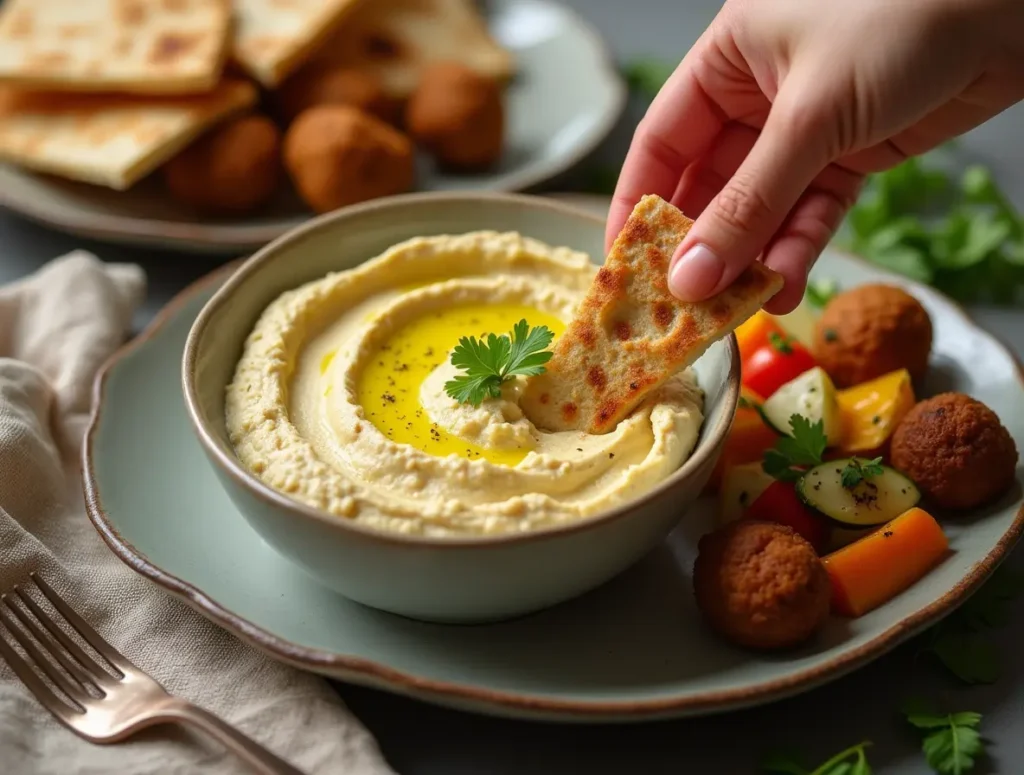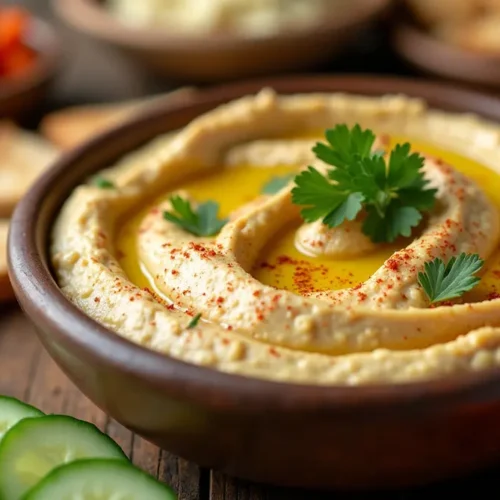Have you ever tried a Lebanese Hummus Recipe so velvety and flavorful that store-bought just doesn’t compare? This creamy, homemade hummus is a staple in Middle Eastern cuisine, made with simple, wholesome ingredients like chickpeas, tahini, fresh lemon juice, and garlic.
The secret to achieving the perfectly smooth texture lies in a few easy techniques that elevate this dip to restaurant quality. Whether you’re pairing it with warm pita bread, fresh vegetables, or grilled meats, this Lebanese Hummus Recipe is a must-try for any hummus lover.
In this guide, I’ll walk you through every step to create the most irresistibly smooth and flavorful hummus right in your own kitchen. Get ready to ditch store-bought for good!
Table of Contents
Key Benefits of This Lebanese Hummus Recipe
Why settle for store-bought when you can make a Lebanese Hummus Recipe that’s fresher, creamier, and bursting with authentic Middle Eastern flavors? Here’s why you’ll love this recipe:
Ultra Creamy Texture: Learn the secret to achieving that silky-smooth consistency just like the best Mediterranean restaurants.
Wholesome & Nutritious: Made with protein-packed chickpeas, heart-healthy olive oil, and antioxidant-rich garlic, this hummus is as nourishing as it is delicious.
Simple Ingredients, Big Flavor: With just a handful of pantry staples, you can whip up a batch in minutes—no preservatives or unnecessary additives.
Versatile & Customizable: Enjoy it as a dip, spread, or side dish! Adjust the garlic, lemon, or spice levels to match your taste preferences.
Meal Prep Friendly: Make it ahead of time and store it in the fridge for a quick, healthy snack or a last-minute appetizer anytime.
Mastering this homemade hummus recipe will not only impress your guests but also give you a go-to dish that’s perfect for snacking, entertaining, and meal prep. Now, let’s dive into the ingredients you’ll need!
Ingredients for the Perfect Lebanese Hummus Recipe

Making the best Lebanese Hummus Recipe is all about using the right ingredients in the right proportions. Here’s what you’ll need to create a smooth, creamy hummus that’s packed with authentic flavors:
- 1 ½ cups canned chickpeas, drained and rinsed Chickpeas are the base of your hummus, providing a creamy texture and subtle flavor. For a smoother result, you can peel the skins off the chickpeas before blending, though this step is optional.
- ¼ cup tahini, Tahini, or sesame paste, is the key ingredient that gives hummus its signature nutty flavor. Make sure your tahini is smooth and runny, not too thick. If it’s too stiff, add a little extra olive oil or water to loosen it up.
- 2 tablespoons fresh lemon juice, Lemon juice adds brightness and a zesty tang, balancing the richness of the tahini and chickpeas. Freshly squeezed is always best!
- 1 clove garlic, minced Garlic gives the hummus depth and flavor. You can adjust the amount based on your preference for a garlicky kick.
- 2 tablespoons extra virgin olive oil, Olive oil adds richness and silkiness to your hummus. Use a good-quality extra virgin olive oil for the best taste.
- ¼ teaspoon ground cumin, optional A pinch of ground cumin will bring a subtle, earthy warmth to the dip. It’s optional but highly recommended for that authentic Middle Eastern taste.
- ¼ cup ice-cold water, Adding cold water helps achieve the ultra-smooth texture that’s the hallmark of perfect hummus. If you prefer a thinner hummus, you can add more water as needed.
- Sea salt to taste A little sea salt brings all the flavors together. Start with a small pinch and adjust to your liking.
These simple, high-quality ingredients are what make this Lebanese Hummus Recipe so special. By using fresh and flavorful staples, you’re guaranteed a rich and creamy dip that’s sure to impress. Now, let’s move on to the next step—blending everything together to create hummus perfection!
Instructions for the Perfect Lebanese Hummus Recipe

Ready to make the creamiest, most flavorful Lebanese hummus? Follow these simple steps to achieve hummus perfection in no time!
- Prepare the Chickpeas: If you’re using canned chickpeas, drain and rinse them thoroughly. For an extra smooth texture, consider peeling the skins off the chickpeas, though it’s completely optional. The skinless chickpeas will blend much smoother, but it’s a bit more time-consuming.
- Blend the Ingredients: In a food processor or blender, add the rinsed chickpeas, tahini, fresh lemon juice, minced garlic, olive oil, and ground cumin (if using). Process for 1-2 minutes, scraping down the sides as needed, until the mixture is smooth.
- Add Ice-Cold Water: Slowly add the ice-cold water, one tablespoon at a time, while continuing to blend. This will help create the ultra-creamy texture you’re looking for. Don’t rush this step—allow the hummus to blend thoroughly, achieving that perfect silkiness.
- Season to Taste: Taste your hummus and adjust the seasoning. Add sea salt and extra lemon juice to balance the flavors if needed. If you want a stronger garlic flavor, feel free to add a little more minced garlic.
- Blend Again: Once you’ve adjusted the seasonings, blend the hummus for another 30 seconds to ensure everything is perfectly combined and smooth.
- Serve & Enjoy: Scoop the hummus into a serving dish, drizzle with extra virgin olive oil, and garnish with a sprinkle of paprika and fresh parsley if desired. Enjoy with pita bread, crunchy veggies, or as a topping for your favorite Mediterranean dishes.
Pro Tip:
For a truly velvety finish, allow the hummus to sit for at least 30 minutes before serving. This gives the flavors time to meld and results in a more robust, well-rounded taste.
With these easy-to-follow steps, you’ll have a homemade Lebanese hummus recipe that’s perfect for any occasion. Ready to dig in?
Pro Tips and Variations for the Best Lebanese Hummus Recipe
Creating the perfect Lebanese hummus is an art, and a few extra tips and variations can elevate your dish to new heights. Here’s how you can fine-tune your recipe to suit your taste and ensure it’s a total hit every time:
Pro Tips for the Creamiest Hummus
- Use Warm Chickpeas: For an extra creamy texture, try using warm chickpeas straight from the can. The warmth helps the tahini and other ingredients blend together more smoothly. If you’re using dried chickpeas, make sure to cook them well and let them cool slightly before blending.
- Peel the Chickpeas: To achieve an ultra-smooth hummus, peel the skin off the chickpeas before blending. It’s a little time-consuming, but it makes a noticeable difference in texture—your hummus will be velvety!
- Perfect Water Ratio: Add ice-cold water gradually while blending. Start with about ¼ cup and add more if needed to achieve the desired texture. For a thicker hummus, use less water; for a creamier consistency, add a little more.
- Tahini Quality Matters: Not all tahini is created equal. Choose a high-quality, smooth, and runny tahini for the best results. If your tahini is thick, try stirring it well or adding a little olive oil to loosen it up before blending.
Flavor Variations to Try
- Roasted Garlic Hummus: Want to mellow out the garlic flavor? Try roasting the garlic beforehand. Roasting garlic brings out a sweet, caramelized taste that adds depth to your hummus.
- Spicy Hummus: If you like a bit of heat, add a pinch of cayenne pepper or ground chili flakes to your hummus while blending. It will give your dip a flavorful kick without overpowering the classic taste.
- Herb-Infused Hummus: Add fresh herbs like parsley, cilantro, or basil for a refreshing twist. Blend them into the hummus or use them as a garnish for a pop of color and flavor.
- Lemon and Sumac: For an even zestier version, try sprinkling a little sumac on top of your hummus along with extra lemon zest. The sumac adds a tangy, citrusy flavor that perfectly complements the creamy dip.
Serving Suggestions
- Serve your Lebanese hummus with warm pita bread, fresh veggies like cucumbers and carrots, or crispy pita chips for a perfect appetizer or snack.
- Use it as a spread on sandwiches or wraps to add a rich, savory flavor.
- Pair with grilled chicken, falafel, or lamb skewers for a full Middle Eastern-inspired meal.
These simple tips and variations will help you customize your Lebanese Hummus Recipe to match your preferences while keeping it irresistibly delicious. Whether you prefer it extra creamy, spicy, or herby, there’s a way to make it just right for you!
Serving Suggestions for Your Lebanese Hummus Recipe

Once your Lebanese hummus is made, it’s time to enjoy it! This versatile dip pairs perfectly with a variety of dishes, making it the ideal addition to any meal or snack. Here are some tasty ways to serve your hummus:
Classic Pairings
- Warm Pita Bread: The classic combo of hummus and pita is always a winner. Tear off pieces of warm, soft pita bread and dip them into the smooth, creamy hummus for a delicious bite.
- Fresh Vegetables: Serve your hummus with crunchy cucumber slices, carrot sticks, or celery. These fresh veggies provide a refreshing contrast to the rich, creamy dip.
- Pita Chips: For some extra crunch, serve your hummus with homemade or store-bought pita chips. They add a delightful texture while complementing the creamy dip.
Protein-Packed Dishes
- Falafel: Another Middle Eastern classic, falafel and hummus are a perfect match. The crispy, spiced chickpea patties pair beautifully with the smooth hummus for a satisfying meal.
- Grilled Chicken: Grilled chicken, especially when seasoned with a bit of cumin or paprika, works wonderfully alongside hummus. The juicy, savory chicken contrasts perfectly with the creamy, tangy dip.
- Lamb Skewers: If you’re looking for something heartier, serve your hummus with grilled lamb skewers. The savory, smoky flavor of the lamb complements the rich hummus beautifully.
Creative Uses
- Hummus on Sandwiches: Spread a generous layer of hummus on sandwiches or wraps instead of mayo or butter. It adds creaminess and a flavorful kick, especially in Mediterranean-style sandwiches with veggies or grilled meats.
- Toppings for Salads: Add a dollop of hummus to your salads for extra creaminess. It’s a great way to add flavor and texture to your greens, especially with simple tabbouleh or Greek salad.
- As a Snack: Hummus is a fantastic snack on its own. Serve it in small bowls for easy, portion-controlled dipping. You can even add a sprinkle of paprika, cumin, or olive oil for a little extra flair.
Garnishing Ideas
- For extra flair and flavor, drizzle a little extra virgin olive oil over your hummus before serving.
- Sprinkle paprika, cumin, or sumac on top for a pop of color and an additional layer of flavor.
- Garnish with fresh parsley or cilantro to add a touch of freshness.
With these serving suggestions, your Lebanese hummus can take center stage at any meal or gathering. Whether you’re looking for a snack, appetizer, or a side dish, this creamy, flavorful dip pairs wonderfully with many options. Don’t hesitate to get creative and enjoy it in different ways!

Lebanese Hummus Recipe
Ingredients
- 1 can 15 oz chickpeas, drained and rinsed
- 1/4 cup tahini
- 1/4 cup freshly squeezed lemon juice about 1 lemon
- 2 tablespoons olive oil
- 1 clove garlic minced
- 1/2 teaspoon ground cumin
- Salt to taste
- 1/4 cup water or more for desired consistency
- Fresh parsley for garnish (optional)
- Paprika for garnish (optional)
- Additional olive oil for drizzling
Instructions
Prepare the Ingredients:
- Drain and rinse the chickpeas, and set them aside. If desired, peel the skins off the chickpeas for a smoother texture (optional).
Blend the Base:
- In a food processor or blender, combine the chickpeas, tahini, lemon juice, olive oil, garlic, and cumin. Blend until smooth.
Adjust Consistency:
- Gradually add water, one tablespoon at a time, until the hummus reaches your desired creamy consistency. Continue blending until it’s completely smooth.
Season:
- Taste and season with salt to your preference. Blend again to incorporate the seasoning.
Serve:
- Transfer the hummus to a serving bowl. Drizzle with olive oil, sprinkle with paprika and fresh parsley, if desired.
Enjoy:
- Serve the hummus with pita bread, fresh veggies, or as a spread on sandwiches.
Notes
- Calories: 180
- Fat: 12g
- Saturated Fat: 1.5g
- Carbohydrates: 15g
- Fiber: 4g
- Sugars: 1g
- Protein: 6g
- Sodium: 190mg
- Cholesterol: 0mg
Conclusion: Why This Lebanese Hummus Recipe Will Become Your Go-To
If you’re looking for a Lebanese hummus recipe that’s both easy to make and packed with flavor, look no further! This homemade hummus is the perfect balance of creamy, tangy, and savory, with just the right amount of garlic and lemon. Whether you’re serving it as a snack, appetizer, or as part of a main meal, this hummus is sure to be a crowd-pleaser.
Here’s why this recipe is a winner:
- Simplicity: With just a few key ingredients, you can create a restaurant-quality hummus right in your own kitchen. No need for complicated processes—just simple, fresh ingredients and a food processor.
- Versatility: It pairs well with virtually any dish. From warm pita bread to grilled meats, or even as a spread on sandwiches, hummus elevates any meal with its rich, smooth texture.
- Customizable: You can easily adjust the flavors to your liking. Whether you want it spicier, zestier, or extra garlicky, there are plenty of ways to customize this Lebanese hummus recipe to fit your tastes.
Next time you’re in need of a quick snack or a flavorful dip for a gathering, whip up this simple, homemade hummus recipe. You’ll be amazed at how easily it comes together and how quickly it disappears from the table!
FAQs: Everything You Need to Know About Making Lebanese Hummus
When making a homemade Lebanese hummus recipe, there are always a few common questions that pop up. Whether you’re new to making hummus or just want to ensure your batch turns out perfect, we’ve got you covered with answers to some frequently asked questions.
1. Can I use canned chickpeas for hummus?
Absolutely! Canned chickpeas are a convenient option and will work just as well for your hummus. Just be sure to rinse and drain them well before using. If you want an even smoother consistency, you can remove the skins of the chickpeas, though this step is optional.
2. How do I make my hummus extra creamy?
To achieve that smooth, velvety texture, the key is in how you blend the hummus. Start by using warm chickpeas, and be sure to gradually add ice-cold water as you blend. Also, don’t skip the tahini—its rich, oily texture is essential for creaminess. For an extra creamy finish, blend the mixture for a longer time, and don’t hesitate to adjust the water or olive oil for the perfect consistency.
3. Can I adjust the flavors?
Yes, you can definitely adjust the flavors to your liking! If you prefer more garlic, add extra minced garlic. Want a tangier kick? Increase the lemon juice or zest. For a spicy variation, try adding a pinch of cayenne pepper or chili flakes. The beauty of Lebanese hummus is that it’s highly customizable to fit your taste preferences.
4. How can I store leftover hummus?
Store any leftover hummus in an airtight container in the refrigerator for up to 4-5 days. To keep it extra fresh, drizzle a bit of olive oil on top before sealing the container. If you’ve made a larger batch, you can also freeze the hummus for up to 1-2 months. Just make sure to let it thaw before serving!
5. Can I make hummus without tahini?
Tahini is a traditional ingredient in Lebanese hummus, but if you don’t have any on hand or prefer a different option, you can substitute it with peanut butter or yogurt for a slightly different flavor. The texture will be a little different, but it still works great!
6. How do I know when my hummus is seasoned just right?
Taste testing is key! Start by adding salt and lemon juice a little at a time, then blend the hummus and taste it. You can always add more seasoning, but it’s hard to take it out once it’s in. Aim for a balance of creamy, tangy, and savory flavors to get that perfect hummus taste.
7. Can I make hummus in advance?
Definitely! In fact, letting hummus sit for a few hours or overnight allows the flavors to meld together, making it even more delicious. Make it ahead of time for a party, or prep it early in the day for a snack later on.
By answering these common questions, we hope you feel more confident in your ability to create the perfect Lebanese hummus every time. Happy cooking, and enjoy your creamy, flavorful dip!



